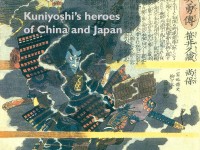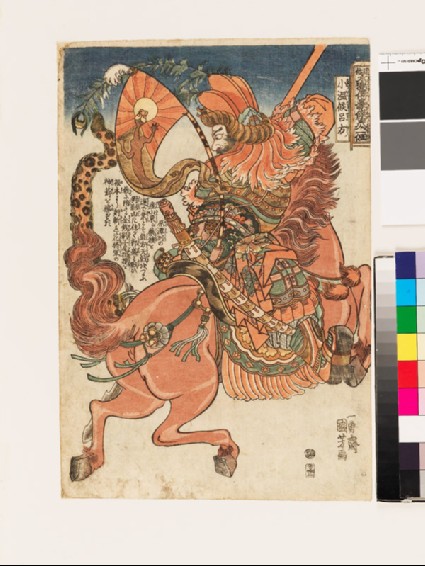Kuniyoshi’s Heroes of China and Japan
A catalogue of the Ashmolean’s collection of warriors by Utagawa Kuniyoshi (1798-1861) by Oliver Impey and Mitsuko Watanabe (published Oxford, 2003).

Publications online: 20 objects
- Reference URL
Actions
Part of a set with...
Shō'onkō Ryohō (Lü Fang)
-
Literature notes
Suikoden chapter 34
Shō'onkō Ryohō, born in Tan-shū (Tan zhou, Shandong province), was a traveling medicine-seller. He lived in Taiei-zan (Duiying shan) where he began robbing travelers, becoming famous for his use of a specific spear known as a hōtengeki. Ryohō fought a celebrated battle with Saijinki Kakusei, another user of the hōtengeki, over who should control the area of Taiei-zan. This battle continued for days until the panther's tails that were special ornaments for their weapons got entangled. Eventually, Shōrikō Kaei (Hua Rong) a powerful local lord urged them to stop fighting, shooting the tails with one arrow. This remarkable feat so impressed them both that later they became his followers. Since then, these two fighters are always depicted as a pair.
This print shows Ryohō in armour on a rearing horse, armed with his long spear and a banner with the insignia of a lizard. The print forms a diptych with that of Saijinki Kakusei (8) [EA1971.94]. -
Details
- Series
- One of the 108 Heroes of the Popular Water Margin
- Associated place
- Date
- 1827 - 1830
- Artist/maker
-
Utagawa Kuniyoshi (1797 - 1861) (designer)
- Associated people
-
Kagaya Kichibei (active c. 1804 - 1880) (publisher)
- Material and technique
- woodblock print, with bokashi (tonal gradation)
- Dimensions
-
mount 55.4 x 40.2 cm (height x width)
print 38.3 x 25.9 cm (height x width)
- Material index
- Technique index
- Object type index
- No. of items
- 1
- Credit line
- Presented by George Grigs, Miss Elizabeth Grigs, and Miss Susan Messer, in memory of Derick Grigs, 1971.
- Accession no.
- EA1971.95
-
Further reading
Impey, Oliver, and Mitsuko Watanabe, Kuniyoshi's Heroes of China and Japan: A Selection of Warriors from Two Series of Prints and a Painting by Utagawa Kuniyoshi (1798 - 1861), the Suikoden of 1827 and the Taiheki of 1848-9 (Oxford: Ashmolean Museum, 2003), no. 9 on p. 10, illus. p. 21 pl. 9
Location
-
- currently in research collection
Objects are sometimes moved to a different location. Our object location data is usually updated on a monthly basis. Contact the Jameel Study Centre if you are planning to visit the museum to see a particular object on display, or would like to arrange an appointment to see an object in our reserve collections.
Publications online
-

Kuniyoshi’s Heroes of China and Japan
Suikoden chapter 34
Shō'onkō Ryohō, born in Tan-shū (Tan zhou, Shandong province), was a traveling medicine-seller. He lived in Taiei-zan (Duiying shan) where he began robbing travelers, becoming famous for his use of a specific spear known as a hōtengeki. Ryohō fought a celebrated battle with Saijinki Kakusei, another user of the hōtengeki, over who should control the area of Taiei-zan. This battle continued for days until the panther's tails that were special ornaments for their weapons got entangled. Eventually, Shōrikō Kaei (Hua Rong) a powerful local lord urged them to stop fighting, shooting the tails with one arrow. This remarkable feat so impressed them both that later they became his followers. Since then, these two fighters are always depicted as a pair.
This print shows Ryohō in armour on a rearing horse, armed with his long spear and a banner with the insignia of a lizard. The print forms a diptych with that of Saijinki Kakusei (8) [EA1971.94].
Notice
Object information may not accurately reflect the actual contents of the original publication, since our online objects contain current information held in our collections database. Click on 'buy this publication' to purchase printed versions of our online publications, where available, or contact the Jameel Study Centre to arrange access to books on our collections that are now out of print.
© 2013 University of Oxford - Ashmolean Museum


